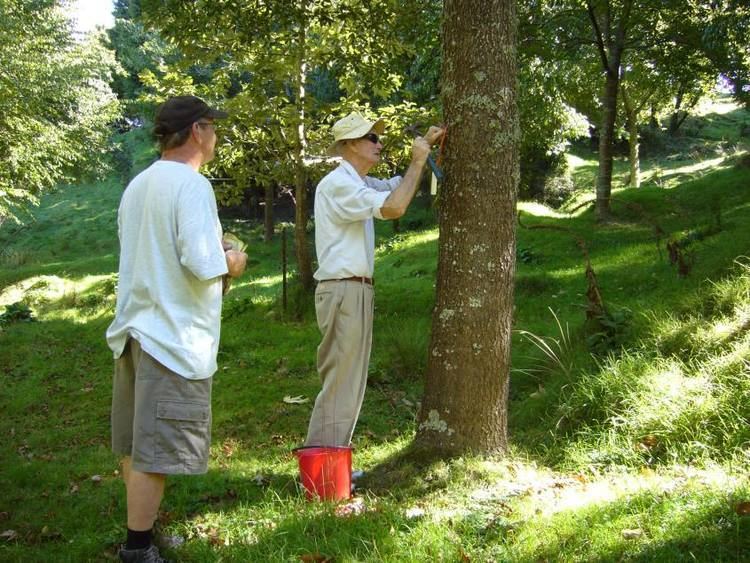Name Bob Berry | Role Dendrologist | |
 | ||
Bob berry mothers day competition 2017
Robert James (Bob) Berry (born 11 June 1916) is a New Zealand dendrologist who founded Hackfalls Arboretum at his farm in Tiniroto, Gisborne. The arboretum is now known for having one of the largest collections of Mexican oaks in the world. During the 1950s and 1960s he was in regular contact with William Douglas Cook, the founder of Eastwoodhill Arboretum, Ngatapa, Gisborne. Berry made the first catalogues of this arboretum, which is now the National Arboretum of New Zealand.
Contents
- Bob berry mothers day competition 2017
- Bob berry usa b 1 everything that s anything
- Biography
- Hackfalls Arboretum
- Eastwoodhill Arboretum
- Awards and honours
- Literature
- References
Bob berry usa b 1 everything that s anything
Biography
Berry was born in Gisborne in 1916. His grandfather was originally from Knaresborough, Yorkshire, England, and had settled in the East Coast area of the North Island of New Zealand in 1889. In 1916 the Berry family bought the majority of Abbotsford Station from the Whyte family, the first European settlers in the area of Tiniroto, a small rural settlement, about halfway along the inland road between Gisborne and Wairoa. The original property of the Berry family at Tiniroto, called Hackfalls, was sold. The name lapsed, but was then used again for the new property, in 1984.
As Berry grew older he developed an interest in trees for their beauty and botanical interest. Most farmers, like his father, planted trees mainly for shelter, timber and fencing, and fruit crops. Long shelterbelts of poplars separate the paddocks and the properties at Tiniroto. During the weekends Berry planted and maintained his growing collection of more unusual trees. Most of the trees were planted around Lake Kaikiore and in the pasture between Lake Kaikiore and Lake Karangata. Berry took over management of the farm in 1950. From this time on his interest and enthusiasm for what had been a hobby reached a new level.
Berry's interest in trees was strongly influenced by William Douglas Cook, the founder of Eastwoodhill Arboretum. In 1953, as a member of the Royal New Zealand Institute of Horticulture, Bob Berry took part in a trip to Eastwoodhill Arboretum. He became a frequent visitor of Eastwoodhill and Douglas Cook offered advice and support to Berry concerning the arboretum at Abbotsford Station.
After Douglas Cook's death, in 1971, Berry started the immense job of making a catalogue of all the trees of Eastwoodhill, with the help of Bill Crooks. The first catalogue was published in 1972. In the same year the first list of trees and shrubs of Abbotsford Station was published. Berry continued updating the catalogue of Eastwoodhill until 1986.
In 1977 a group of members of the International Dendrology Society (IDS) visited Abbotsford Arboretum for the first time. Berry joined the IDS, and in October 1982 joined a tour to Mexico, which was the beginning of a particular interest in Central American Oaks (Quercus sp.). This trip was followed by several others to Mexico to collect acorns.
Berry remained in charge of Abbotsford Station until 1984, when his niece, Diane, and her husband Kevin Playle took over the management of the farm. The name of the station changed (back) to Hackfalls Station at that moment, and Berry could spend more time with his trees.
In 1990 Bob Berry welcomed another group of IDS members at Hackfalls Arboretum, led by Lady Anne Palmer. Later the same year Berry married Lady Anne. She played an important role in the development of the homestead garden at Hackfalls Station, being an eminent plantswoman in her own right.
In 1993 the arboretum was protected by a covenant with the Queen Elizabeth II National Trust. It now covers about 50 ha. and contains over 3,500 trees and shrubs.
In July 2006 Bob and Anne Berry left the homestead of Hackfalls Station and moved into the town of Gisborne.
He turned 100 in June 2016.
Hackfalls Arboretum
Berry originally planned to make maples the main tree collection of his arboretum. However, he soon discovered that the land was better suited to growing oak trees. There are now about 90 different maples, mostly species, but also some hybrids and cultivars. There are 45 species of Mexican oaks, plus several forms and hybrids. Together with specimens from other regions the oaks have reached a total of about 150 different taxa.
Eastwoodhill Arboretum
Berry met Douglas Cook, the creator of Eastwoodhill Arboretum, in 1953. After Cook's death Berry helped "with identifying and labelling. In 1971, increasingly concerned at the lack of a proper catalogue, he began the huge task of locating and identifying every plant and plotting them on a grid laid over an aerial map. With (Bill) Crooks as his right-hand man, Berry produced a catalogue of some 3000 plant species and varieties and with it the proof that Eastwoodhill was worth preserving".
